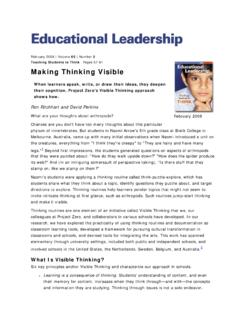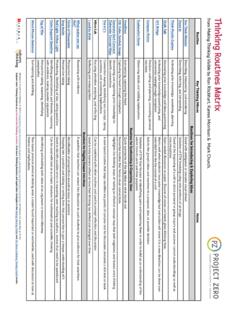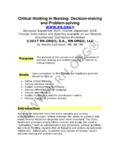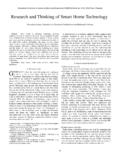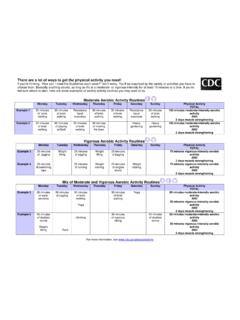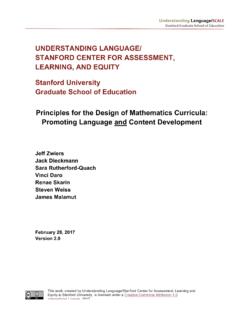Transcription of THINKING ROUTINES FOR MAKING THINKING VISIBLE
1 THINKING ROUTINES FOR MAKING THINKING VISIBLE ROUTINES for Introducing and Exploring Ideas ROUTINES for Synthesising and Organising Ideas ROUTINES for Digging Deeper into Ideas ROUTINES for Introducing and Exploring Ideas SEE -THINK-WONDER Looking at an image or object: What do you see? What do you think is going on? What does it make you wonder? SEE - THINK - WONDER Purpose: SEE emphasizes the importance of observation as the basis for THINKING and provides time to observe before interpreting Having WONDER as the last step ensures that students had time to take in new information through their observing and THINKING . WONDER opens up new areas to be explored. Appropriate Content Uses and Variations Assessment and Tips Images can include a painting, a SEE-THINK-WONDER can be done SEE shows attention to details. photo, an artifact, a video clip, an one step at a time or by using the THINK responses should provide excerpt of text, a chart, or a found three prompts together at the support.
2 Object. same time. WONDER statements should be Images should have an element of This routine is generally used at broad and adventurous . ambiguity, and many different layers the beginning of a unit of study. Students using a worksheet give of explanation, as well as a large degree of detail. Questions can be raised that might shorter responses so this routine is guide future inquiry. best done orally. The Steps 1. Set Up: Present the image in a way that allows students to see it in as much detail possible. You can project it on the whiteboard or each team can have a copy to look at. Students are given 2 to 3 minutes to observe without any talking or discussion. 2. See: Ask students to state what they noticed. They should only share what they could see and give no interpretations. 3. Think: Ask students what they think is going on in the image. The goal is to build up layers of tentative interpretations.
3 Respond to students' answers with requests for evidence such as: What do you see that makes you say that? 4. Wonder: Ask students what they are now wondering about based on what they have seen and have been THINKING . Wondering is about asking broader questions that push us beyond our interpretations to look at issues and ideas raised by the object. 5. Share the THINKING : Students share their THINKING at each step along the way before moving on to the next one. The class can begin to build on the group's THINKING and the discussion can become richer because of it. The Technology Connections -', ZOOM IN ZOOM IN Purpose: Look closely at the small bit of image that is revealed: What do you see or notice? What is your hypothesis or interpretation of what this might be, based on what you are seeing? This THINKING routine causes students to deal with limited information and it enables them to see that it is helpful to be open-minded and flexible.
4 This routine causes learners to act as detectives and build up meaning, individually and as a group. Reveal more of the image: What new things do you see? How does this change your interpretation? Has the new information answered any of your wonders or changed your previous ideas? Repeat the reveal and questioning process until the whole image has been revealed: What lingering questions remain for you about this image? Appropriate Content -Uses and Variations ! Assessment and Tips Consider whether the image has separate areas that tell a different story and if the parts are as interesting as the whole. The content might be a scene with many people doing different things with the initial reveal showing just one person or activity. Content must be engaging and meaningful to the subject area. Use an illustration to immerse students in a text and to develop an understanding of the setting or time period.
5 In social studies you can use a map. As ZOOM IN progresses, more cartographic information is revealed. There is no set number of reveals to use. Walk yourself through the reveals and determine what type of information is revealed and if it will engage students. The Steps 1. Set up: Display a section of the selected image and invite students to look at it. Allow time for careful observation. You can ask for observations before moving to the next step. Interpretations can be done individually, in small groups, or with the total class. 2. Reveal: Uncover more of the image. Ask students to identify new details. Ask them how these newly observed details affect their previous interpretations. You can ask about their wanderings as well. 3. Repeat: The process is continued. Ask students to discuss their different ideas and reflect on how their THINKING changed as a result of the reveals. 4. Share the THINKING : Discuss the process of ZOOM IN.
6 Ask students how their interpretations changed over time. Ask them how seeing more influenced their THINKING . The Technology Connections THINK -PUZZLE -EXPLORE THINK -PUZZLE -EXPLORE Consider the subject or topic just presented: What do you think you know about this topic? What questions or puzzles do you have about this topic? How might you explore the puzzles we have around this topic? ~ -Purpose: THINK-PUZZLE-EXPLORE is a routine that encourages students to connect to their prior knowledge, to be curious, and plan for independent or group inquiry. Teachers can get an idea of students' understanding of a topic and can develop the setting for deeper inquiry. The routine can also be used at the conclusion of a unit as a reflective tool. Appropriate Content Uses and Variations Assessment and Tips Select complex and rich topics that lead to questions that invite multiple interpretations Subject can be a big idea or an article in the paper, or anything that is relevant to students and is worth understanding at a deeper level.
7 The routine can be taught to parents and used in small groups on field trips. THINK identifies misconceptions students have about a topic. PUZZLE lets teachers know about what students are interested in exploring further. EXPLORE is an opportunity to determine students' ability to plan an inquiry. The Steps 1. Set up: This routine helps shape the study to follow. Plan on some form of documentation. Students in small groups can document their conversation or use sticky notes that can be posted on butcher paper. 2. Ask: What do you think you know about .. Ask the question and give students time to think. Have students either state their ideas or jot them down. Stating their ideas allows others to build upon them. 3. Ask: What questions or puzzles do you have? Stress the THINKING part by asking students to wonder more about the topic with further questions such as: What would be interesting to learn more about?
8 What are you wondering about? Are there things about this topic about which you are curious? 4. Ask: How can we explore these puzzles? Have students select a puzzle from their list. Share and discuss how one would explore the puzzles further. Ask: Whom might you ask? Where could you get more information? What would you key search words be? What could you do other than search for information? How could you find ways to answer your own puzzles? 5. Share the THINKING : THINKING can be shared as a whole group. If you share in small groups, have them report out. Students can then choose to work in pairs or small groups to plan the exploration of the puzzle they found most interesting. ----The Technology Connections CHALK TALK CHALK TALK Purpose Looking at the topic or question written on the chart paper: What ideas come to mind when you consider this idea, question, or problem? This routine asks students to think about ideas, questions, or problems by silently responding in writing both to the prompt and to the thoughts of others.
9 All students can participate in the open-ended and exploratory nature of the routine. What connections can you make to others' responses? What questions arise as you think about the ideas and consider the responses and comments of others? Appropriate Content Uses and Variations Assessment and Tips Appropriate content includes Makes room for all learners to Look for relevance. single words or phrases related to have a voice Check to see if contributions relate a topic of study. Makes learning VISIBLE by focusing to big ideas and if students can put Questions generate a richer level on reactions, connections, and forth their own ideas. of discussion. questions If responses seem limited it may be Content should invite multiple CHALK TALK can be used to that the prompt was too narrow. perspectives. encourage reflective THINKING . The Steps 1. Set up: Write the prompts on large sheets of chart paper.
10 Place the charts on tables around the room. Put markers on each table. Determine the groups and assign them to one of the charts. 2. Present the CHALK TALK prompt: Ask students to think about their reactions to the prompt. Have them record their ideas and questions. Have learners read and add to each other's responses with additional comments and questions. 3. Circulate: Provide time for students to circulate and read the responses of another group. Have them add to the prompts and responses. Continue the rotation until all groups have been to all charts. 4. Facilitate: The teacher acts as a facilitator, prompting the groups about the types of responses they can make as they read. They can connect ideas, elaborate on others ideas, or comment on what others have written, or write a question asking for more detail. 5. Share the THINKING : Have groups return to their original chart. Have the groups review what was written on their chart.
